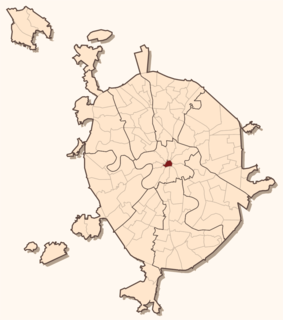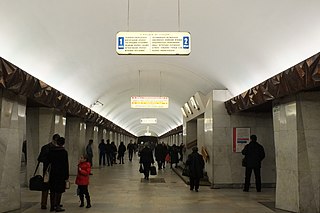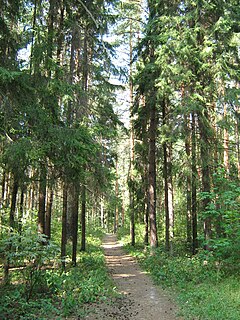
The East Slavs are Slavic peoples speaking the East Slavic languages. Formerly the main population of the loose medieval Kievan Rus federation state, by the seventeenth century they evolved into the Belarusian, Russian, Rusyn and Ukrainian people.

Old East Slavic or Old Russian was a language used during the 10th–15th centuries by East Slavs in Kievan Rus' and states which evolved after the collapse of Kievan Rus', from which the Russian, Belarusian, Ukrainian and Rusyn languages later evolved.

Eastern Slavic naming customs are the traditional way of identifying a person's given name and patronymic name in countries formerly part of the Russian Empire or the Soviet Union.

A gord is a medieval Slavic fortified wooden settlement, sometimes known as a burgwall after the German term for such sites. Gords were built during the late Bronze and early Iron Ages by the Lusatian culture, and up to the 7th–8th centuries CE and beyond by other cultures, in what is now Poland, the Czech Republic, Hungary, Slovakia, eastern Germany, Romania, Moldova, Belarus, Serbia, Croatia, Bosnia and western Ukraine. These settlements were usually founded on strategic sites such as hills, riverbanks, lake islands, or peninsulas.
Old Novgorod dialect is a term introduced by Andrey Zaliznyak to describe the dialect found in the Old East Slavic birch bark writings. Dating from the 11th to 15th centuries, the letters were excavated in Novgorod and its surroundings.

A bogatyr or vityaz is a stock character in medieval East Slavic legends, akin to a Western European knight-errant. Bogatyrs appear mainly in Rus' epic poems—bylinas. Historically, they came into existence during the reign of Vladimir the Great as part of his elite warriors (druzhina), akin to Knights of the Round Table. Tradition describes bogatyrs as warriors of immense strength, courage and bravery, rarely using magic while fighting enemies in order to maintain the "loosely based on historical fact" aspect of bylinas. They are characterized as having resounding voices, with patriotic and religious pursuits, defending Rus' from foreign enemies and their religion. In modern Russian, the word bogatyr labels a courageous hero, an athlete or a physically strong person.

Kitay-gorod, also referred to as the Great Possad in the 16th–17th centuries, is a cultural and historical area within the central part of Moscow in Russia, defined by the remnants of now almost entirely razed fortifications, narrow streets and very densely built cityscape. It is separated from the Moscow Kremlin by Red Square. Kitay-gorod does not constitute a district (raion), as there are no resident voters, thus, municipal elections are not possible. Rather, the territory has been part of Tverskoy District, and the Central Administrative Okrug authorities have managed the area directly since 2003.

The northern Russian dialects make up one of the main groups of the Russian dialects.

Russian architecture follows a tradition whose roots lie in early Russian wooden architecture and in the architecture of Kievan Rus' with its centers in Veliky Novgorod and Kyiv. From the Rus' era, the Byzantine Empire influenced the architecture and culture of Russia. In other phases of Russian history the architecture developed independently and was characterized by national and local features. After the fall of Kyiv, Russian architectural history continued in the principalities of Vladimir-Suzdal, Novgorod, and the succeeding states of the Tsardom of Russia. The great churches of Kievan Rus', built after the adoption of Christianity in 988, were the first examples of monumental architecture in the East Slavic region. Early Eastern Orthodox churches were mainly built from wood, with their simplest form known as a cell church. Cathedrals often featured many small domes, which has led some art historians to infer how the pagan Slavic temples may have appeared.

Kitay-gorod is a Moscow Metro station complex in the Tverskoy District, Central Administrative Okrug, Moscow, Russia. It is on the Kaluzhsko-Rizhskaya and Tagansko-Krasnopresnenskaya lines. Kitay-gorod is one of the four stations within the Moscow Metro network providing a cross-platform interchange.

Samara Metro, formerly known as the Kuybyshev Metro, is a rapid transit system which serves the city of Samara, Russia. Opened in 1987, it consists of one line with ten stations and approximately 12.7 kilometres (7.9 mi) of bi-directional track.

The Ushkuyniks, also Ushkuiniks or Russian pirates were free and democratic people from early Rus' state which originated in northern regions of Russia, medieval Novgorod, composed of Slavic people like the Ilmen Slavs or Novgorod Slovenes, Finno-Ugrics and Vikings who supposedly led the Viking-like life of fighting, killing, and robbery. The Ushkuyniks were widespread in large parts of the Russian north and sailed on the arctic ocean. The origin of the term Ushkuyniks is unknown. Most likely the word "ushkuy" derives from the Oskuya River in Russia. Most likely the term is also connected to the Russian word for tight or narrow, узко (usko), узкий, plural: узкие (uzkiye). Furthermore medieval Finnic type of flat-bottom ships are called uisk. In Eastern Slavic languages word "Uzh" (уж) translates natrix, and it was common for Norsemen to sail on narrow longships called "drakkar", which roughly translates as "serpent" from Old Norse. This translation of information shows a cultural connection between Northern Europeans. These ships could be easily transported over portages between watersheds, is also considered as the namesake.

The Nizhny Novgorod Metro, formerly known as the Gorky Metro, is a rapid-transit system which serves the city of Nizhny Novgorod, Russia. Opened in 1985, it consists of 15 stations and is 21.6 kilometres (13.4 mi) long. The metro connects with the City Rail system at the Moskovskaya station. It has the third-largest number of stations of any Russian subway system, the largest two being Moscow and St. Petersburg.
A modern Belarusian name of a person consists of three parts: given name, patronymic, and family name (surname), according to the Eastern Slavic naming customs, similar to Russian names and Ukrainian names.

Zelyony Gorod is an urban locality in Nizhny Novgorod Oblast, Russia, located in a forested area to the southeast of Nizhny Novgorod and surrounded by the territory of Kstovsky District. Population: 2,716 (2010 Census); 2,437 (2002 Census); 4,234 (1989 Census).

Historic Monuments of Novgorod and Surroundings is a composite World Heritage Site which includes a number of medieval monuments in and around Veliky Novgorod, Russia. The site was inscribed in 1992.
Grad is an Old Slavic word meaning "town", "city", "castle" or "fortified settlement". Initially present in all related languages as gord, it can still be found as grad, gradić, horod or gorod in many placenames today.

The Likhud Brothers were two Greek monks from Cephalonia who founded and managed the Slavic Greek Latin Academy in Moscow between 1685 and 1694. Their names were Ioannikios Leichoudes or Ioannikii Likhud and Sophronios Leichoudes or Sofronii Likhud.














